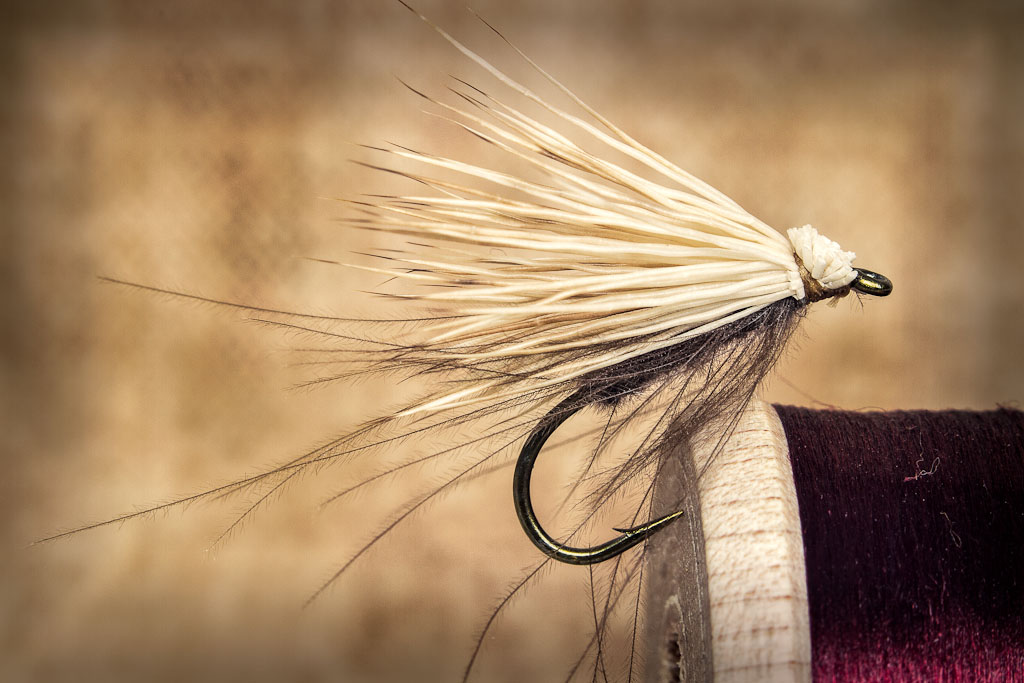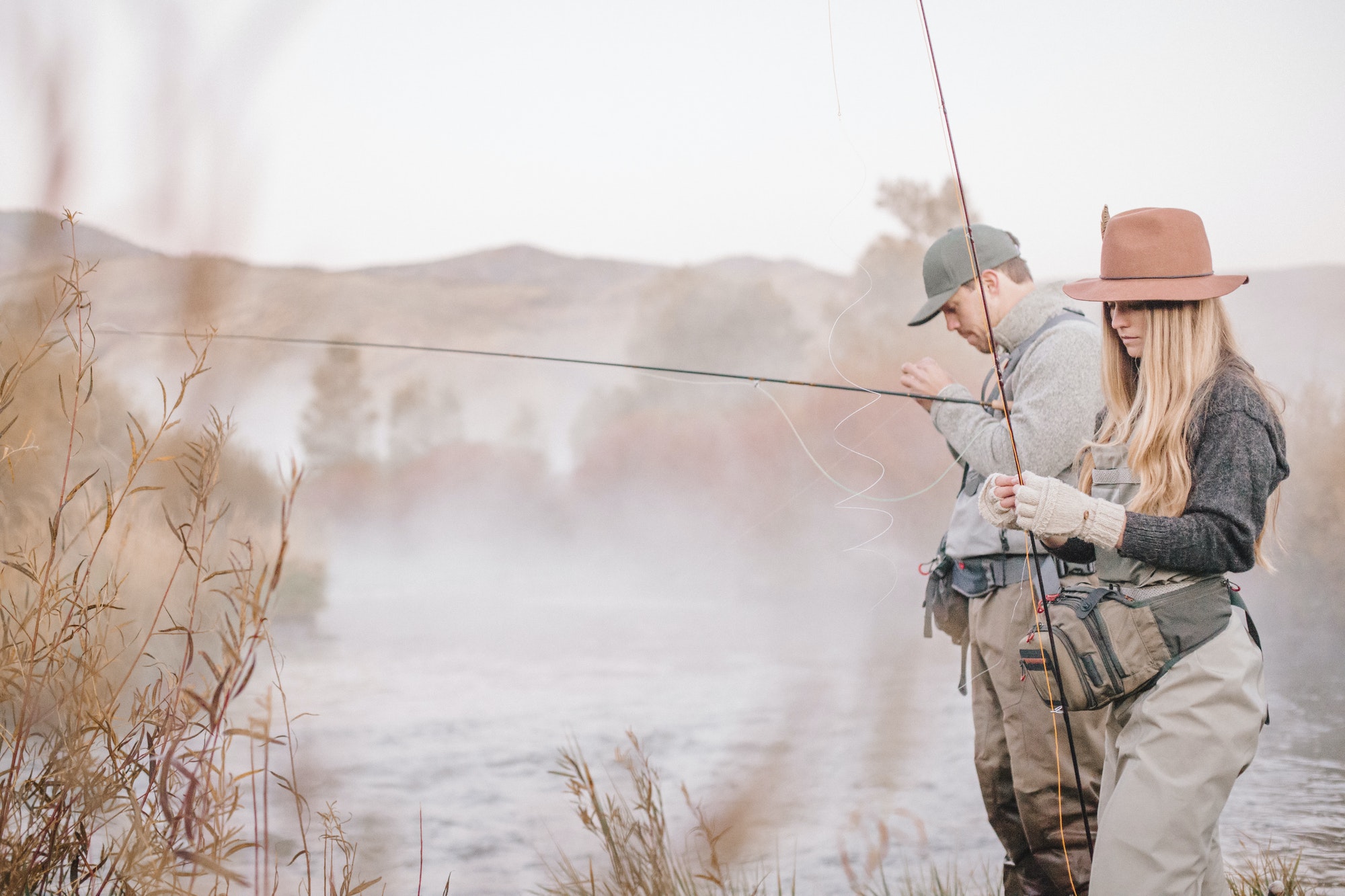
CDC Elk Hair Caddis
Hans Weilenmann was born to be the Babe Ruth of fly tying
Hans Weilenmann’s contributions to the world of fly fishing and, most significantly, fly tying for coldwater game fish is well known to upper shelf fly tyers the world over and in Europe by anyone tying flies for trouts.
One of Hans’ many specialties is using cul de canard feathers in a variety of his patterns, perhaps most notably in his signature fly, the very effective and versatile CDC & Elk.
His interest in fly-tying, macro photography and a background in computing and networking, all came together in Flytier’s Page, a magnificent web site created by him to showcase fly tiers and their patterns from around the world. If you have not looked at his website before, you are in for a very pleasant surprise!
NOTE: The following article was written by L. Grandison and reprinted with permission.
Hans Weilenmann was born on 18 June 1954 in Winterthur, Switzerland he subsequently moved at an early age to the Netherlands where he currently resides in Amstelveen, The Netherlands. He is husband to Samina and father to Mikhail, with a second child due July 1996. When not flyfishing or tying he works as a computer specialist at Elsevier Science b.v., a scientific publishing house, where he actually gets paid for spending time on another hobby: computers and networks.
Casting Club of Amsterdam
He took up fishing early at he age of six conquering carp and pike in the native water of the Netherlands. At eighteen he decided to take up flyfishing. In order to learn to cast “properly” with a fly rod, he joined the Casting Club of Amsterdam. This lead to participation in national and international casting tournaments. As a member of the Dutch casting team he has participated in European and World Championships. While no longer active in tournaments, Hans still teaches flycasting and the techniques and styles of casting remain a strong area of interest for him.
For his flyfishing he mostly travels to Germany or the British Isles, while longer fishing trips have taken him to the rivers and streams in other parts of Europe, the US, Canada and New Zealand. While he enjoys fishing with his bamboo rods, a trip to New Zealand has made him aconvinced convert to the practical advantages of travelling/fishing with pack rods.
Weilenmann began tying flies in 1972
He began trying out many techniques and styles. The number of flyboxes in his vest steadily grew. As a result the weight of his vest acquired semi-legendary status among his friends and became a source of concern for many of the major airlines. One story goes that a fellow angler short of flies removed half of Hans’ flies surreptitiously and Hans was none the wiser. Only after years of guilt was this revealed to Hans who expressed surprize at this undetected loss.
After those frantic early no-holds-barred years he decided to focus his tying skills and concentrate on producing flies that catch fish under a wide range of conditions and were uncomplicated yet elegant. In his words:
Flies to catch fish, not fishermen.His tying is based on a few simple rules which his fishing flies have to meet:
1. Quick and easy to tie. (No point in spending half an hour making a trout fly, only to loose it in seconds to a branch or rock)
2. To use only (good quality) materials which are inexpensive and easily obtained. (Patterns which specify the use of whiskers of a muskrat simply don’t cut it)
3. Balanced, well proportioned appearance. (Behave well during casting and drift)
4. Suggest something of sufficient protein content to interest a fish. The key word here is suggest’. (The fish has to take the fly before you can hook it)
5. Durable. (Flies put together should stay together)
6. If a dry fly, it should float well. If a wet, nymph or streamer, it should cut through the surface film cleanly. (Make sure the design and choice of materials is suited to the task)
He has found kindred spirits in the Dutch American Association of Fly Tiers (D.A.A.F.T.), a dedicated group of flytiers with a sense of humour. One annual D.A.A.F.T. tying event Hans has really enjoyed the last few years would be when Leo Lambrichs, the past proprietor of the Kelson Collection of rare bird feathers would bring unusual selections of feathers for the tiers to use in creating new patterns. Sadly Leo died unexpectedly late 1995 and the “Crazy Feather Day” may be a thing of the past.
Hans places his tying firmly in the impressionistic corner
Weilenmann wonders how tiers who tie super-realistic patterns imitating naturals as closely as they possibly can, manage to reason away this strange bit of curved metal protruding from the back of their creations. His flies utilize almost exclusively natural materials, as he prefers the variegated colors and structures found in nature over the mostly uniform color and structure of synthetics. There are very few insects of a solid color, so why not copy this mix of colors in your imitations. This does not mean that synthetics are never used, because they may have other properties which are desirable, but natural materials are the bread and butter in his tying. The natural materials are used both “as is” and dyed. Hans is particularly fond of the beautiful olive color which is the result of using picric acid as the dye. Olive dyed partridge, pine squirrel, hare, rabbit and mole are used extensively.
He has been teaching tying classes for many years now and finds teaching flytying not only enjoyable to do, but it also yields benefits for his own tying. In his words ” It forces one to examine and re-examine the reasons why one prefers one method or technique over an other. If you cannot explain why to yourself, then how can you expect to convince somebody else?”

It’s about the fly, isn’t it? Envato image.
Self taught
When asked about the way in which he learned to tie flies he explains that he is mostly self taught. In the early seventies books on flytying were scarce in Holland, and those which were available were pretty basic. Flytying videos completely unheard of. Later on, as a flood of flytying books became available and contact with other tiers (domestic and international) became more frequent, different styles and techniques were observed, and where appropriate, taken on board.
He has demonstrated at a number of shows in Europe, including all the FlyFairs. (The FlyFair is Europe’s largest international outdoor flyfishing show) In the US he has been a tier at several of the FFF national conclaves and the International Fly Tyers Symposiums.
His articles and flies have appeared in several English, German and US magazines. Six of his favorite flies can be found in his chapter in The Worlds’s Best Trout Flies, edited by John Roberts
Using good quality materials make tying neat flies easier. Likewise, good tools make for a more enjoyable (and more productive) session at the tying bench. Hans cites a good chair, light, vise, scissors and hackle pliers as essential tools which should be the best one can afford. He calls himself sometimes the Man of Many Vices (the English spelling being preferred because it has more room to manoeuvre’. He has bought and used over the years many a vise, looking for the ultimate tying tool. He believes he has found it in the British made LAW vise. Hans collaborated with the maker, Lawrence A. Waldron, in developing the vise and both men have been very pleased with the result.
Of interest
Pet peeve: Tiers who take themselves and their tying too seriously.
Favorite place to fish: New Zealand’s South Island.
Other interests include reading, listening to music, (macro) photography and eating ice cream.
A design which has become a signature fly for him is the CDC and Elk, fly patterned after the Elk Hair Caddis. It incorporates a whole CDC feather, including the stem into the body and hackle. Not so much to enhance floatation, although it does that also, but more to increase the action of the fly with the wispy CDC ends.
The required list of materials for the The CDC & Elk is pretty short (standard dry-fly hook, thread, CDC feather (natural or dyed) and fine-tipped deer hair.

Here April Vokey helps out a fellow tyer at a fly tying symposium. April Vokey is a modern day superstar of fly tying. She has made waves throughout the steelhead world as a fly fisher and made many contributions to tying steelhead flies and in particular tube flies.
The CDC & Elk tying instructions:
• Attach the thread halfway down the hook shank and run backwards to the bend.
• Select a CDC feather of the required color and size. (The longest barbule approx. 2 times shank-length) Hold the CDC feather at the butt and, by stroking the feather between thumb and index finger towards the tip, bunch the tips together.
•Tie in the bunch, butt pointing backwards. Tie down with two turns, then slip a third turn under the tips and a fourth turn over the barbules, just forward of the third. This will lock the CDC barbules in place and prevent them from coming loose. Spiral thread forward to eye, then back one turn.
• Clamp butt with hackle pliers and wind the CDC feather towards the eye in touching turns. You will find that the rear half of the body will resemble a dubbed one, but as you progress towards the eye, more and more free barbules appear. Stroke these backwards with each turn. A little practice will enable you to arrive at the eye with only the bare part of the stem left.
• Tie off with one tight turn of thread, unclip the hackle but do not trim yet. Tighten with a second and third turn of thread. You will see that the CDC butt will move with the thread, securing the tie-off point. Clip the CDC butt.
• Finish off as a regular EHC. I like to trim the deer-hair to the required length before tying it in. Your usage may vary.
This article was written by L. Grandison and reprinted with permission. Lindsey Grandison, grandiso@umdnj.edu Physiology & Biophysics UMDNJ, Robert Wood Johnson Medical School 675 Hoes Lane Piscataway, New Jersey 08854-5635
FYI: Go to YouTube and Google Hans Weilenmann’s name along with fly tying. I bet you can’t just watch one.







